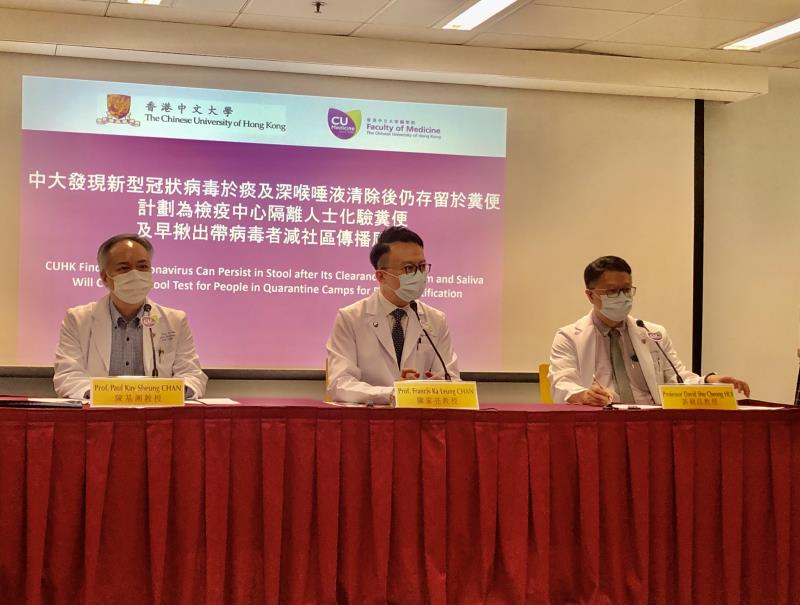 From left: Prof Paul Chan, Prof Francis Chan, Prof David Hui
From left: Prof Paul Chan, Prof Francis Chan, Prof David HuiThe severe acute respiratory syndrome coronavirus 2 (SARS-CoV-2) is detected in stool specimens of all hospitalized patients with coronavirus disease 2019 (COVID-19) in a study, with a viral load comparable to that of deep-throat saliva specimens. According to researchers from the Chinese University of Hong Kong (CUHK), stool may be used as an alternative to deep-throat saliva for COVID-19 screening.
In the study, the CUHK researchers collected and analyzed 339 specimens from 14 hospitalized COVID-19 patients (seven male, seven female). The specimens were collected from the patients’ respiratory tract (nasopharynx, n=90; sputum, n=52; deep-throat saliva, n=33), stool (n=59), blood (n=57), and urine (n=48) during hospitalization at Prince of Wales Hospital or United Christian Hospital.
“All stool and respiratory specimens tested positive for SARS-CoV-2,” reported Professor Paul Chan of the Department of Microbiology, CUHK. “All patients had their stool samples testing positive for SARS-CoV-2 during the course of their illness, regardless of disease severity.”
“Three patients, or about 20 percent, still had the virus detected in their stool specimens for 1–2 days after their respiratory specimens had become negative,” said Professor Francis Chan, Dean of the Faculty of Medicine, CUHK.
The median viral load of stool specimens was 12,000 copies/mL – similar to the viral load of 10,000 copies/mL of deep-throat saliva specimens.
Sputum specimens had the highest median viral load (3,200,000 copies/mL), followed by nasopharyngeal specimens (51,000 copies/mL). Only 29 percent of blood samples tested positive, and their median viral load was the lowest (4,000 copies/mL). All urine samples tested negative.
“These results suggest that self-collected stool specimens may be used as an alternative or in complement to self-collected deep-throat saliva specimens for detection of SARS-CoV-2 in individuals with dry cough, given the 42 percent false-negative rate of testing of the latter. Further studies are needed to determine the role and use of stool specimens in various scenarios,” said Professor Paul Chan. “In individuals with productive cough, sputum remains the self-collected specimen of choice for SARS-CoV-2 detection.”
“Our findings are similar to those of a recent study in China, in which about 23 percent [17 of 73] of hospitalized COVID-19 patients had stool specimens testing positive for SARS-CoV-2 even after respiratory specimens had become negative,” said Professor Francis Chan. [Gastroenterol 2020, doi: 10.1053/j.gastro.2020.02.055]
“The finding of virus shedding in stool has important public health implications in terms of early identification of asymptomatic COVID-19 cases in the community, as well as hand hygiene measures for caregivers of the elderly and individuals who handle food,” he continued. “We will conduct a study to test stool and saliva specimens of 100 asymptomatic close contacts of confirmed COVID-19 cases who have been admitted to quarantine centres. The study will enable us to determine whether stool testing can effectively identify COVID-19 in asymptomatic individuals. This is something we want to do urgently, and we are currently liaising with the Department of Health [DH].”
Meanwhile, CUHK is offering free stool tests for COVID-19 screening to asymptomatic children arriving in Hong Kong by air in collaboration with DH. The stool specimens will be analyzed at CUHK’s laboratory, with results provided to DH the next day. According to Professor Paul Chan, this first-phase initiative is launched in view of the difficulty in collecting deep-throat saliva specimens from infants and young children. The scheme is expected to be extended to returnees in other age groups subsequently.